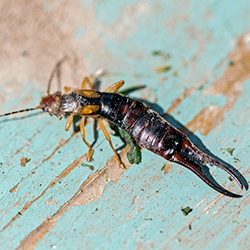Summertime is a time for barbecues, spending time poolside, and working in the garden. A time to relax and enjoy the lazy, crazy hazy days of summer. But if your yard has been invaded by numerous pests, then perhaps your summer isn't so enjoyable. And we aren't only talking about mosquitoes. We all know mosquitoes can ruin an outdoor event but here are several other outdoor pests that can become problems as well.
Millipedes
Millipedes are brownish and are 1-4 cm long and segmented with 2 pairs of legs per segment. Typically found outdoors in damp places, these can be found under mulch or dead leaves or under structures such as storage sheds. Millipede eggs are deposited in the soil. Most millipede species reach reproductive maturity in their second year and live several years after that.
Earwigs
Earwigs are strange looking insects that have pincers, or forceps, protruding from their abdomen. Though intimidating looking, they are not poisonous. Depending on the species, these creatures can measure from 5-25 mm in length. They are slender and have 2 pairs of wings. Some species of earwigs produce a foul smelling liquid used as a defense, and earwigs, in general, tend to cluster together in large numbers.
Clover Mites
These are oval shaped, 8-legged, red colored insects that are about the size of the head of a pin. These mites lay eggs in sidewalk cracks, walls of buildings, and other dry places. Their populations can quickly become large since females can lay up to 70 eggs--and each egg can become a mature adult in 30 days. And clover mites reproduce by parthenogenesis, which means that the females can reproduce without being fertilized by males.
Springtails
These are tiny insects which range from .25 to 6 mm in length. Their name comes from a spring-loaded structure found on the underside of their abdomen which can hurl the insect into the air up to 10 centimeters. These creatures usually live in damp soil, eating mold and fungus. They are common in flowerbeds and under logs or woodpiles.
Problems Caused By These Pests
In fall, millipedes often migrate out of their normal habitat and find their way into homes, sometimes in great numbers. Though earwigs do not actually burrow into people's brains and lay eggs, as legend has it, they can frighten people because of their pincers, and they can become a significant garden pest if conditions are right. Clover mites, if they make their way into homes, can cause red staining on fabrics if they are crushed, and can be a concern if they gather in large numbers. And springtails, if they invade a home, can become difficult to eradicate without professional help. It is worth noting, as well, that if any of these creatures are getting into your home, there could be any number of other, more dangerous pests lurking in your wall voids, basement, and other secluded areas.
If you would rather live in a home free of disturbing pests, reach out to All-American Pest Control. We are happy to help. The lazy, crazy hazy days of summer are simply nicer when pests are under control.
 1426 Reviews
1426 Reviews


